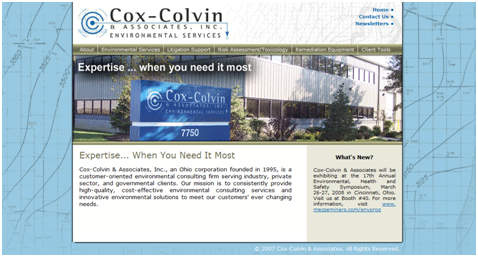Tuesday, November 29, 2011
Renewable Energy Production on Contaminated Sites
As part of the RE-Powering America's Land Initiative, the EPA and US Department of Energy's National Renewable Energy Laboratory (NREL) are evaluating the feasibility of developing renewable energy production on Superfund, brownfields, hazardous waste, and former landfill or mining sites. EPA is investing about a million dollars for the project that pairs EPA's expertise on contaminated sites with the renewable energy expertise of NREL. Wind, solar, biopower, or geothermal production on use-restricted property makes a lot of sense, and should be considered in evaluating long-term use of contaminated property. For more information, visit EPA's Repowering website.
Labels:
Dept of Energy,
EPA guidance,
NREL,
RE-powering,
renewable energy
Monday, November 21, 2011
Cox-Colvin Presented on Soil-Gas Prospecting at AIPG Meeting
I presented a talk in September 2011 at the American Institute of Professional Geologists (AIPG) National Meeting in Bloomingdale, Illinois titled "The Use of Innovative Soil-Gas Sampling Methods to Locate VOC Sources". The presentation, which discussed how Cox-Colvin used the Vapor Pin to collect soil gas from beneath the floor of a large industrial facility to locate sources of volatile organic compound (VOC) contamination, was very well received. The use of the Vapor Pin, combined with collecting soil gas into disposable, evacuated glass vials, allowed us to collect approximately 240 samples over the entire building footprint in one week, using only hand-held equipment.
As we've seen at other sites, VOC contamination at this site was not located beneath former degreasing operations or storage tanks. Instead, using aerial photos and historic maps to reconstruct the building's history, we found that the contamination was located where loading docks and back doors used to be prior to building expansion. Before the Clean Water Act in 1977, it was accepted practice to dump used solvents on the ground - commonly through the nearest door. By now it's unlikely that any present employees remember dumping of waste, or would be comfortable discussing it if they did. But by sampling subslab soil gas in a grid over the entire building, and tying the analytical results to the building expansion history, we located an unsuspected source of VOCs and determined that it probably resulted from spillage or dumping prior to 1952. Better yet, the sample points were installed, sampled, and plugged each day at minimal cost and without interrupting plant operations. And when we're done locating sources, the soil-gas data will be useful for assessing vapor intrusion.
As we've seen at other sites, VOC contamination at this site was not located beneath former degreasing operations or storage tanks. Instead, using aerial photos and historic maps to reconstruct the building's history, we found that the contamination was located where loading docks and back doors used to be prior to building expansion. Before the Clean Water Act in 1977, it was accepted practice to dump used solvents on the ground - commonly through the nearest door. By now it's unlikely that any present employees remember dumping of waste, or would be comfortable discussing it if they did. But by sampling subslab soil gas in a grid over the entire building, and tying the analytical results to the building expansion history, we located an unsuspected source of VOCs and determined that it probably resulted from spillage or dumping prior to 1952. Better yet, the sample points were installed, sampled, and plugged each day at minimal cost and without interrupting plant operations. And when we're done locating sources, the soil-gas data will be useful for assessing vapor intrusion.
Labels:
AIGP,
chlorinated solvents,
forensic,
soil gas,
source,
subslab,
Vapor Intrusion Sampling,
VOC
EPA to Study Potential Impacts of Hydraulic Fracturing on Drinking Water Resources
EPA recently published its plans to conduct a comprehensive national study on the potential impacts of hydraulic fracturing on drinking water resources. The study will evaluate the impacts associated with the entire hydraulic fracturing water life cycle. The results, which will be available in 2014, have the potential to significantly impact the perception and regulation of hydraulic fracturing.
Read More>>
Read More>>
Subscribe to:
Posts (Atom)




